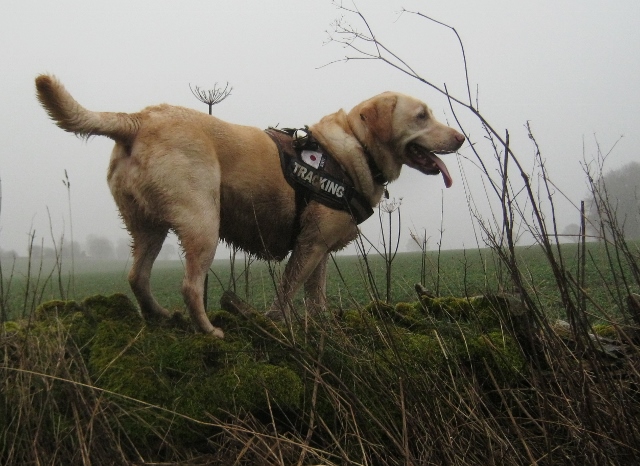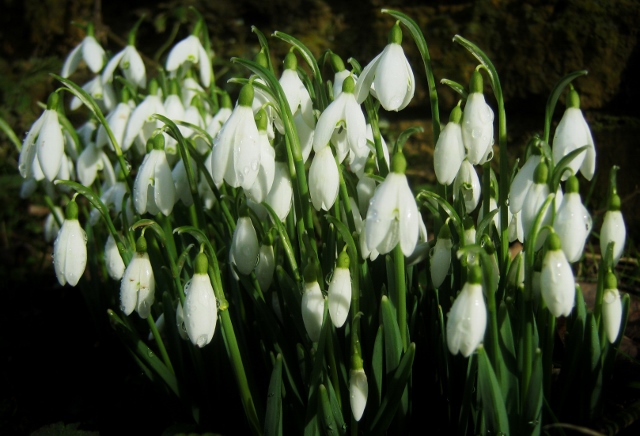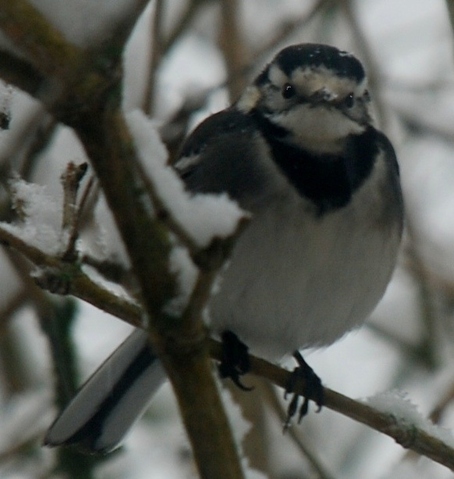00 00 0 099 007.JPG
Picture 1
Tess attempted to pick up the scent trail of the very big and grizzled old boar Badger who has lived alone in this sett for the past few months. He was the only one to survive when the cullers paid him and his clan a visit last year and he has since refused to allow any new Badgers to share his home. Tess had no luck picking up a trail however and a close examination of the area immediately surrounding the sett entrances revealed no sign of any Badger activity whatsoever within the past week or so.
Drawing
a complete blank therefore and with Tess clearly convinced that there were no Badgers actually within the sett itself, we moved off to search for Badger sign in the surrounding woods and fields….
Picture 2
It was beginning to get dark (hence the very poor quality of the pictures and using flash photography when attempting to track wild animals in poor light is definitely not a good idea) when Tess suddenly came to an abrupt halt fifty or so yards ahead of me, clearly ‘pointing’ to something off to her right.
The breeze was coming from that direction and, as I drew to within a few yards of her, I finally caught the same smell that had stopped her full in her tracks….the putrid and gaggingly unpleasant stink of something very dead.
Picture 3
It was the old boar Badger himself. Dead for about a week and rapidly decomposing.
Picture 4
Short on time because of the fast-fading light, I was at least able to determine a number of important facts before darkness fell completely….
(i)….
This was an almost identical type of killing pattern/methodology to the one involving the little Muntjac Deer pictured further down the page.
(ii)….
This kill site was less than a mile from the Muntjac kill site.
(iii)….This very large Badger had been ‘ambushed’ about twenty-five yards away in a woodland clearing almost certainly from the top of an old, partly demolished wall, whereupon, a gargantuan struggle had seemingly taken place in the vicinity of the wall with soil and decayed leaf litter (humus) churned up all over the place and a wide variety of plants damaged with some still in a fairly flattened state.(iv)….Death, as with the Muntjac, appeared to be by asphyxiation apparently caused by some kind of protracted choking bite/hold to the throat (what could do that to a full-grown boar badger?)!
(v)
This attack probably took place about a week after the Muntjac kill with the carcass then being dragged to a much more secluded and sheltered spot. A big old boar Badger like this one will easily weigh up to forty or forty-five pounds….I know because I’ve taken TB-related blood and urine samples from scores of dead Badgers (usually road-kill victims) in recent years and because this one was killed in a fairly secluded, off-the-beaten-trail sort of place, there’s not a dog in the world that would bother to drag such a heavy carcass twenty-five yards just get a little bit of extra cover. A dog would be more than happy to eat such a kill in situ.
(vi)
Drag marks, still very evident even after a week, easily confirmed that the Badger had most definitely been killed in the clearing by the wall and subsequently dragged to the feeding site.
(vii)
The bite dimensions were less clear due to body swell and general decomposition factors, but were approximately the same as the bite marks on the Muntjac. Other, claw-type marks were apparent on the Badger’s back and flanks when I turned the carcass over, but the maggot-bloated state of the carcass (it was absolutely full of them) made accurate measurements virtually impossible, though I made them anyway.
(viii)
Again, as with the Muntjac, feeding entry had be from the rear with the softer tissues being eaten first (as would a Fox), but it was something as hungry for bone marrow (if not hungrier) as it was the more readily available soft tissues and organs (and with a bite ratio strong enough to crack fairly thick bone) that had bitten clean through the Badger’s femur.
(ix)
There was absolutely no human track or spoor-sign apparent at either the kill site or the feeding site. That doesn’t mean that there weren’t any humans involved, it just means that I couldn’t find any trace of one.
(x)
Only fragments of the attackers' track-sign were still visible and were pretty much inconclusive and even the Badger’s track-sign was barely recognizable. However, clumps and individual strands of hair torn from the badger during the attack were inter-mingled with hair from an, as yet, unidentified animal, samples of which I have sent off for scientific examination together with several of the Badger’s front claws.
(xi)
I can’t stress enough that if this big boar Badger was truly attacked and killed by another animal, then the attacker(s) must have had exceptional fighting ability and a considerable weight advantage….not to mention a strong element of surprise born out of an ambush predator mentality….and an awful lot of luck. Remember, a Badger is actually a great big Weasel and, like all members of the Weasel tribe, they are truly awesome fighters….tenacious, courageous and vicious in equal measure. All but a very small handful of apex predators anywhere in the world (and, even then, only those subject to a significant deficit in the common sense department) are stupid enough to take on a Mustelid in a one-to-one situation….Particularly one weighing somewhere in the region of forty to forty-five pounds….and armed with the fiercest set of canines found anywhere in the UK….as well as a fully lockable pair of jaws (“you get bit by a Badger, you stay bit!” as my Uncle Chris the gamekeeper once told me when I was a boy)….and a full set of claws that even Wolverine would be proud of….Bearing in mind that a Wolverine is a giant Weasel too….and only a fraction bigger than a Badger!
Anyway, I’m convinced I’m getting closer to solving this mystery one way or another once and for all!



